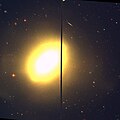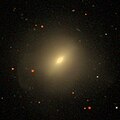Top Qs
Timeline
Chat
Perspective
NGC 3610
Elliptical galaxy in the constellation Ursa Major From Wikipedia, the free encyclopedia
Remove ads
NGC 3610 is an elliptical galaxy in the constellation Ursa Major.[6] It was discovered on 8 April 1793 by German-British astronomer William Herschel.[7] This galaxy is located at a distance of 106 million light-years (32.5 Mpc) from the Milky Way,[4] and is receding with a galacto-centric radial velocity of 1,819 km/s.[3]
NGC 3610 is a relatively young elliptical galaxy which has not yet lost its disk.[6] It has a morphological classification of E5,[8] indicating a 2:1 ratio between the major and minor axes of the elliptical profile. This is a candidate merger remnant of intermediate age, with a surviving disk of gas and dusk aligned with the major axis.[9] This merger is estimated to have occurred 4±2.5 Gyr ago. The central part of the disk displays warping,[8] and is significantly younger than the remainder of the galaxy.[8]
The unusual amount of blue light emission of NGC 3610, or B–V in the UBV photometric system, suggests recent star formation.[9] The current estimated star formation rate is 0.385±0.375 M☉·yr−1.[4] There is a population of younger globular clusters orbiting the galaxy that is a likely product of the merger. The surviving population of older, metal-rich globular clusters suggests that at least one of the progenitor galaxies had a prominent bulge component.[9]
Remove ads
Gallery
- NGC 3610 by Hubble Space Telescope
- NGC 3610 (SDSS DR14)
References
Further reading
External links
Wikiwand - on
Seamless Wikipedia browsing. On steroids.
Remove ads



